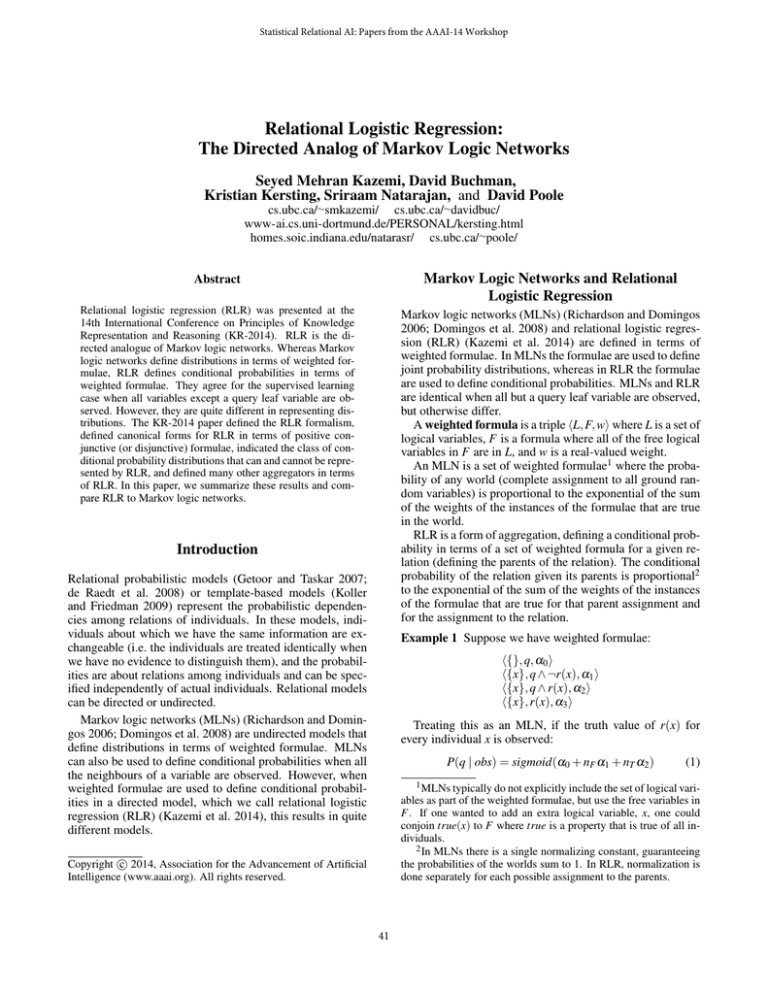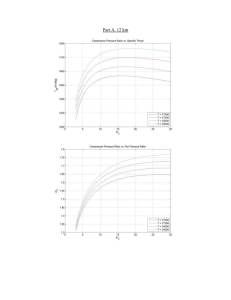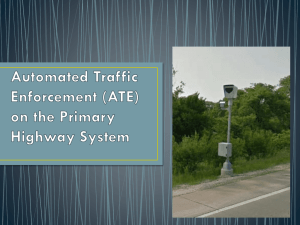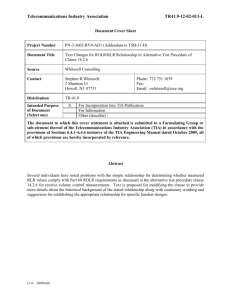
Statistical Relational AI: Papers from the AAAI-14 Workshop
Relational Logistic Regression:
The Directed Analog of Markov Logic Networks
Seyed Mehran Kazemi, David Buchman,
Kristian Kersting, Sriraam Natarajan, and David Poole
cs.ubc.ca/∼smkazemi/ cs.ubc.ca/∼davidbuc/
www-ai.cs.uni-dortmund.de/PERSONAL/kersting.html
homes.soic.indiana.edu/natarasr/ cs.ubc.ca/∼poole/
Abstract
Markov Logic Networks and Relational
Logistic Regression
Relational logistic regression (RLR) was presented at the
14th International Conference on Principles of Knowledge
Representation and Reasoning (KR-2014). RLR is the directed analogue of Markov logic networks. Whereas Markov
logic networks define distributions in terms of weighted formulae, RLR defines conditional probabilities in terms of
weighted formulae. They agree for the supervised learning
case when all variables except a query leaf variable are observed. However, they are quite different in representing distributions. The KR-2014 paper defined the RLR formalism,
defined canonical forms for RLR in terms of positive conjunctive (or disjunctive) formulae, indicated the class of conditional probability distributions that can and cannot be represented by RLR, and defined many other aggregators in terms
of RLR. In this paper, we summarize these results and compare RLR to Markov logic networks.
Markov logic networks (MLNs) (Richardson and Domingos
2006; Domingos et al. 2008) and relational logistic regression (RLR) (Kazemi et al. 2014) are defined in terms of
weighted formulae. In MLNs the formulae are used to define
joint probability distributions, whereas in RLR the formulae
are used to define conditional probabilities. MLNs and RLR
are identical when all but a query leaf variable are observed,
but otherwise differ.
A weighted formula is a triple hL, F, wi where L is a set of
logical variables, F is a formula where all of the free logical
variables in F are in L, and w is a real-valued weight.
An MLN is a set of weighted formulae1 where the probability of any world (complete assignment to all ground random variables) is proportional to the exponential of the sum
of the weights of the instances of the formulae that are true
in the world.
RLR is a form of aggregation, defining a conditional probability in terms of a set of weighted formula for a given relation (defining the parents of the relation). The conditional
probability of the relation given its parents is proportional2
to the exponential of the sum of the weights of the instances
of the formulae that are true for that parent assignment and
for the assignment to the relation.
Introduction
Relational probabilistic models (Getoor and Taskar 2007;
de Raedt et al. 2008) or template-based models (Koller
and Friedman 2009) represent the probabilistic dependencies among relations of individuals. In these models, individuals about which we have the same information are exchangeable (i.e. the individuals are treated identically when
we have no evidence to distinguish them), and the probabilities are about relations among individuals and can be specified independently of actual individuals. Relational models
can be directed or undirected.
Markov logic networks (MLNs) (Richardson and Domingos 2006; Domingos et al. 2008) are undirected models that
define distributions in terms of weighted formulae. MLNs
can also be used to define conditional probabilities when all
the neighbours of a variable are observed. However, when
weighted formulae are used to define conditional probabilities in a directed model, which we call relational logistic
regression (RLR) (Kazemi et al. 2014), this results in quite
different models.
Example 1 Suppose we have weighted formulae:
h{}, q, α0 i
h{x}, q ∧ ¬r(x), α1 i
h{x}, q ∧ r(x), α2 i
h{x}, r(x), α3 i
Treating this as an MLN, if the truth value of r(x) for
every individual x is observed:
P(q | obs) = sigmoid(α0 + nF α1 + nT α2 )
(1)
1 MLNs typically do not explicitly include the set of logical vari-
ables as part of the weighted formulae, but use the free variables in
F. If one wanted to add an extra logical variable, x, one could
conjoin true(x) to F where true is a property that is true of all individuals.
2 In MLNs there is a single normalizing constant, guaranteeing
the probabilities of the worlds sum to 1. In RLR, normalization is
done separately for each possible assignment to the parents.
c 2014, Association for the Advancement of Artificial
Copyright Intelligence (www.aaai.org). All rights reserved.
41
where obs has r(x) is true for nT individuals, and false for
nF individuals out of a population of n individuals (so n =
nT + nF ), and sigmoid(x) = 1/(1 + e−x ).
Note that in the MLN, α3 is not required for representing
the conditional probability (because it cancels out), but can
be used to affect P(r(Ai )), where Ai is an individual of x.
In Kazemi et al. (2014), the sigmoid, as in Equation (1), is
used as the definition of RLR. (Kazemi et al. (2014) assumed
all formulae were conjoined with q∧, and omitted q∧ from
the formulae.) RLR only defines the conditional probability
of q given each combination of assignments to the r(x) (using Equation (1)); when not all r(x) are observed, separate
models of the probability of r(x) are needed.
In summary: RLR uses the weighted formulae to define
the conditional probabilities, and MLNs use the weighted
formulae to define the joint probability distribution.
where obs has r(x) true for nT individuals out of a population of n. The use of two different logical variables of the
same population in a formula (e.g. x and y in the last formula of this example) allows a sigmoid-of-a-quadratic dependency on the population sizes (nT , nF , n).
This example uses only positive conjunctions (but needs
to have the “extra” logical variables). This is one of the
canonical representations for RLR. Using the canonical
forms for RLR, Kazemi et al. (2014) proved that in RLR,
each conditional probability is the sigmoid of a polynomial
of counts. Moreover, any conditional probability that is a
sigmoid of polynomials of counts can be represented by
RLR.
Example 4 Suppose we have a set of movies and the ratings people gave to these movies in a star-rating system. We
define a movie to be “popular” if the average of its ratings is
more than 3.5. In this case, we have a parametrized random
variable popular(m) which is a child of a parametrized random variable rate(p, m). The following weighted formulae
can approximate the conditional dependence of popular(m)
on its parent (the second weighted formula is repeated 5
times for different values of i ∈ {1, 2, 3, 4, 5}):
Example 2 Suppose people want to go to a party and the
party is fun for them if they know at least one social person
in the party. In this case, we have a parametrized random
variable f unFor(x) which is a child of two parametrized
random variables, knows(x, y) and social(y). The following weighted formulae can be used to model the dependence
of the relation f unFor(x) on its parents:
h{m}, popular(m), −εi
h{m, p}, popular(m) ∧ rate(p, m) = i, i − 3.5i
h{x}, f unFor(x), −5i
h{x, y}, f unFor(x) ∧ knows(x, y) ∧ social(y), 10i
RLR sums over the above weighted formulae and takes the
sigmoid resulting in:
RLR sums over the above weighted formulae and takes the
sigmoid, resulting in:
P(popular(m) = True|Π) = sigmoid(−ε + s − 3.5n)
P( f unFor(x) = True|Π) = sigmoid(sum), sum = −5 + 10nT
where s denotes the sum of the ratings and n represents the
number of ratings for this movie. The value inside the sigmoid is positive if mean = ns > 3.5 and is negative otherwise
(ε is used to ensure the the value inside the sigmoid is negative when mean = 3.5). This example demonstrates how
the aggregator mean can be represented by RLR. It has been
demonstrated in (Kazemi et al. 2014) that many other popular aggregators such as OR, AND, noisy-OR, noisy-AND,
max, more-than-t trues, more-than-t% trues, and mode can
be represented in terms of RLR.
where Π is the assignment of values to the parents,
and nT represents the number of individuals y for which
knows(x, y)∧social(y) is True for the given x. When nT = 0,
sum < 0 and the probability is close to 0; when nT > 0,
sum > 0 and the probability is close to 1.
Example 3 This example is similar to Example 1, but uses
only positive conjunctions3 , and also involves multiple logical variables of the same population.
h{}, q, α0 i
h{x}, q ∧ true(x), α1 i
h{x}, q ∧ r(x), α2 i
h{x},true(x), α3 i
h{x}, r(x), α4 i
h{x, y}, q ∧ true(x) ∧ true(y), α5 i
h{x, y}, q ∧ r(x) ∧ true(y), α6 i
h{x, y}, q ∧ r(x) ∧ r(y), α7 i
Related Work
Logistic regression has been previously used in relational
domains for learning purposes. Popescul et al. (2002) use
inductive logic programming (ILP) to generate first-order
rules for a target relation, create features by propositionalizing the rules, and then use logistic regression to learn a
classifier based on these features.
Similar ideas to RLR have been used for discriminative
learning in MLNs. Huynh and Mooney (2008) use an ILP
technique to generate discriminative clauses for a target relation and then use logistic regression with L1-regularizer
to learn the weights with automatic feature selection (automatic structure learning). They empirically demonstrate
how their discriminative model outperforms MLNs when
there is a single target relation. Their work can be considered
as one approach for learning an RLR conditional probability
for a relation when all its parents are observed.
In RLR and in MLNs, if the truth value of r(x) for every
individual x is observed:
P(q|obs) = sigmoid(α0 + nα1 + nT α2 + n2 α5 + nT nα6 + n2T α7 )
3 Here
true(x) is true of every x. This notation is redundant.
For the traditional MLN notation, one can remove the explicit set
of logical variables and keep the true(·) relations. If you are happy
with the explicit logical variables, you can remove the true(·) predicates. Removing both is incorrect. Keeping both is harmless. You
could add formulae that involve negations or disjunctions, but they
are redundant (Kazemi et al. 2014).
42
Conclusion
The paper introducing relational logistic regression (RLR)
(Kazemi et al. 2014):
• Defines RLR in terms of weighted formulae
• Investigates how conditional probabilities are defined
based on the number of (tuples of) individuals for which
each weighted formula holds
• Presents non-redundant canonical forms for the formulae,
e.g., positive conjunctions
• Proves that a conditional dependency of child relation on
population sizes of its parents can be represented by RLR
if and only if it can be represented as the sigmoid of a
polynomial of these population sizes
• Shows how other aggregators can be represented by RLR,
including OR, AND, noisy-OR, noisy-AND, mean> t,
max, more-than-t trues, more-than-t% trues, and mode.
References
de Raedt, L.; Frasconi, P.; Kersting, K.; and Muggleton, S.
2008. Probabilistic Inductive Logic Programming: Theory
and Applications. Springer-Verlag.
Domingos, P.; Kok, S.; Lowd, D.; Poon, H.; and Richardson, M. 2008. Markov Logic. In Raedt, L.D., Frasconi, P.,
Kersting, K. and Muggleton, S., eds., Probabilistic Inductive
Logic Programming. Springer.
Getoor, L., and Taskar, B. 2007. Introduction to Statistical
Relational Learning. MIT Press, Cambridge, MA.
Huynh, T. N., and Mooney, R. J. 2008. Discriminative structure and parameter learning for markov logic networks. In
Proc. of the international conference on machine learning.
Kazemi, S. M.; Buchman, D.; Kersting, K.; Natarajan, S.;
and Poole, D. 2014. Relational logistic regression. In Proc.
14th International Conference on Principles of Knowledge
Representation and Reasoning (KR-2014).
Koller, D., and Friedman, N. 2009. Probabilistic Graphical
Models: Principles and Techniques. MIT Press, Cambridge,
MA.
Popescul, A.; Ungar, L. H.; Lawrence, S.; and Pennock,
D. M. 2002. Towards structural logistic regression: Combining relational and statistical learning. In KDD Workshop
on Multi-Relational Data Mining.
Richardson, M., and Domingos, P. 2006. Markov logic
networks. Machine Learning 42:107–136.
43



